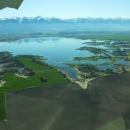About Us
Lost Trail National Wildlife Refuge was established on August 24, 1999 and became the 519th refuge in the National Wildlife Refuge System. It was established for: use by migratory birds, conservation of fish and wildlife resources, fish and wildlife oriented recreation and the conservation of endangered or threatened species. Lost Trail National Wildlife Refuge contains four broad types of habitats: lakes and wetlands, riparian riparian
Definition of riparian habitat or riparian areas.
Learn more about riparian areas, intermountain grasslands (especially bunchgrass prairie), and forest. The wetlands provide important migration and breeding habitat for waterfowl and other waterbirds, and riparian habitat provides important migration and breeding habitat for songbirds. Refuge grasslands offer critical winter habitat for large mammals such as mule deer and elk. Bald eagles, falcons, hawks, and owls find excellent roosting and nesting habitat in the forest. In addition, the forest is hunting habitat for lynx and potential denning habitat for the grizzly bears and gray wolves that live near the Refuge and that once inhabited the lands now within the Refuge.
Our Mission
Lost Trail National Wildlife Refuge is an integral part of the Columbia River ecosystem and the Pleasant Valley community. The Refuge is a place where wetlands, streams, native grasslands, and forests have been conserved, enhanced, and restored. These habitats support a variety of migratory birds, species of concern, and other associated wildlife and plants. People learn about and appreciate the natural and cultural environment of the Refuge and enjoy opportunities for wildlife-dependent recreation. Partnering with others fosters natural and cultural resource conservation for the benefit of present and future generations.
Our History
Lost Trail National Wildlife Refuge is located in the west-central portion of Flathead county in the serene and picturesque mountain drainage known as Pleasant Valley. The Refuge was acquired in August 1999. Prior to acquisition, Refuge lands were privately owned and managed as a cattle and horse ranch known as Lost Trail Ranch.
Because the Refuge is relatively new, many public use activities are limited at this time. Refuge policy and regulations require the development of various public use plans before activities can be allowed. These plans will receive public input during the administrative planning process. Public use activities that are currently allowed include hunting, wildlife observation, wildlife photography, and environmental education.
During the Pleistocene Epoch, glaciers pushed south out of Canada to smooth and shape the underlying Precambrian Belt rocks which are now visible on the higher hills along the north edge of the refuge.
Pleasant Valley was formed during the Pleistocene Epoch by glacial contraction, expansion and sedimentation activity after glacial melt at the end of the last ice age. The glaciers pushed south out of Canada to smooth and shaped the underlying Precambrian Belt rocks, a sedimentary formation deposited more than a billion years ago. This bedrock is visible on the higher hills along the north edge of the Refuge and in some road cuts along the main road through the refuge. Glacial deposits sit atop the older Belt Rock formation, which faulted over younger Paleozoic rocks. Receding glaciers often leave behind enclosed basins, some of which now contain lakes. Although there are examples of these kinds of lakes south of the Refuge, Dahl Lake was not formed this way. A glacial lake covered much of Pleasant Valley at the end of the last ice age. Although most of the valley was drained during the 1900’s, the stream gradients are so low that water still accumulated in the floodplain during spring runoff. Dahl Lake is a remnant of this old glacial lake. Restoration of the Refuge wetlands is a priority and the Dahl Lake restoration is just the beginning.
From early Native American life to an extensive European settlement, Pleasant Valley has rich archaeological and historical resources.
Native Americans - 5000 Years of Use Prior to European Settlement
Native Americans have long used western Montana and were first written about by Lewis and Clark during their journey through the areas over 200 years ago. According to the Confederated Salish and Kootenai Tribal Historical Preservation Office, the native people of the area included the Bitterroot Salish, Pend d’Oreille, and Kootenai. Today all three tribes make up the CSKT of the Flathead Indian Reservation. During the 5,000 years of pre-history in the Kootenai River Valley, people wintered in the valley bottoms and moved to higher elevations to hunt and gather foods.
The area around the refuge, including Pleasant and Lost Prairie valleys, was within the immediate home range for the Kootenai people. Even though they were trading partners with the Salish and Pend d’Oreille tribes, the Kootenai spoke a different language. The Kootenai place name for Pleasant Valley is yaqakmu’inki and it was a major travel corridor from the Little Bitterroot River and Flathead Lake to the Upper Fisher River and Kootenai River Valley.
Salish and Kootenai traveled to Wolf Creek to hunt deer and elk in the fall and went to huckleberry grounds in the summer. The Kootenai people at Wolf and Fisher rivers traded furs with settlers in the early 1800’s. Native Americans harvested camas bulbs along the shores of Dahl Lake and in low wetlands during early spring. Some of these camas areas are still present today.
Grave sites, teepee rings and a petroglyph site have all been documented on the Refuge.
European Settlement - Ranchers and Railroads
Some of the earliest Europeans to use Pleasant Valley were those from Plains Montana. They brought cattle in from the west along Fisher Creek to summer range in the valley. About 1886, the first homesteader, Charlie Lynch, settled a homestead just south of Lynch Lake. Others soon followed, most being cattlemen moving from Plains to the valley. Bill Orr and Frank Gardiner settled in Pleasant Valley in 1888. Orr homesteaded about halfway between the North 1019 Road and the South Pleasant Valley Road, with Gardiner setting up just east of his partner. Bill Orr built his ranch house in 1914; it also served as the Pleasant Valley post office from 1916 to 1933.
In November 1941, Art and Velma Lund bought the former Orr-Gardiner place. They lived there for approximately six years in the original log cabin part of the house. After 29 years of ranching in the Pleasant Valley, the Lund’s sold their ranch in 1970. These buildings still stand today and provide housing for the Refuge staff.
Jack Nowlan homestead in Pleasant Valley in 1888, near the refuge’s current headquarters. Nowlan and Edwin Vesey claimed the original water rights on Pleasant Valley Creek, just west of the ranch. In 1910, Ed Jackson purchased the Nowlan homestead which became the Jackson Ranch. Over the next 27 years, he built a variety of structures including a house, horse barn, cow barn and log garage. These structures are still standing and in use by the Refuge staff with the exception of the cow barn, which burned down.
George and Frank Doll were also among the early homesteaders that set up within the present day boundary of the refuge. Frank and his wife Josephine homesteaded along the east side of Medicine Lake (now known as Dahl Lake) in 1900. His brother George settled northwest of him. The Dolls and a partner from Spokane organized the Pleasant Valley Ranch Company in 1912. They bought and leased other homesteads in the valley. They sold the company in 1927.
The Great Northern Railroad’s main east to west line (Kalispell to Libby) ran through Pleasant Valley from 1892 to 1904. The railroad grade reached 1.5 percent at locations on its climb from Bitterroot Lake to Pleasant Valley. This steepness and the large number of curves along the route led the Great Northern to build a different track west from Whitefish bypassing Pleasant Valley altogether. During the Great Northern Railroad’s operation, a railroad stop and section house were built just east of the current Refuge headquarters. A construction ramp and railroad gravel pit existed just north of this area. The Pleasant Valley railroad line closed in October 1904.
The Pleasant Valley Road opened in 1917 and followed the old railroad grade. Although residents made rail fences from the old railroad ties, old railroad spikes can still occasionally be found coming out of the roadbed.
The first Pleasant Valley School opened in 1903 in an old railroad cabin – it was located behind the Jackson Ranch. After 2 years, the school was moved approximately 2 miles east where it stayed until 1914. From 1914 to 1960, the Pleasant Valley School was situated near the junction of Lost Prairie Road and the Old Railroad Grade.
In 1971, an absentee owner from San Francisco purchased the Pleasant Valley Ranch and renamed it Lost Trail Ranch. The ranch was resold in 1981 to absentee partners who extended the boundaries through purchases of the Jackson and Orr-Gardiner ranches. In 1996, the Montana Power Company purchased the Lost Trail Ranch as potential mitigation for wetland loss on the Flathead Waterfowl Production Area. In 1999 Montana Power Company conveyed approximately 3,100 acres of the ranch to the Service, which purchased the remaining acreage from Montana Power Company. In 1999 the Lost Trail National Wildlife Refuge was established.
Other Facilities in this Complex
Lost Trail National Wildlife Refuge is managed by the Northwest Montana Wetland Management District as part of the Western Montana National Wildlife Refuge Complex. A Complex is an administrative grouping of two or more refuges, wildlife management areas, or other refuge conservation areas that are managed from a central location. Refuges are grouped into complexes because they occur in a similar ecological region, such as a watershed or specific habitat type, and have a related purpose and management needs.
For the Western Montana National Wildlife Refuge Complex, the project leader is stationed at Benton Lake National Wildlife Refuge and oversees general management of the Complex. Refuge managers oversee the operations at specific refuges. Supporting staff, composed of administrative, law enforcement, refuge manager, biological, fire, visitor services, and maintenance professionals support all refuges within the complex.
The District headquarters is located at PO Box 547 Ronan, MT, 5986
406-750-8242
The Complex headquarters is located at Benton Lake National Wildlife Refuge, 922 Bootlegger Trail, Great Falls MT 59404.
The refuges in the Western Montana National Wildlife Refuge Complex include:

